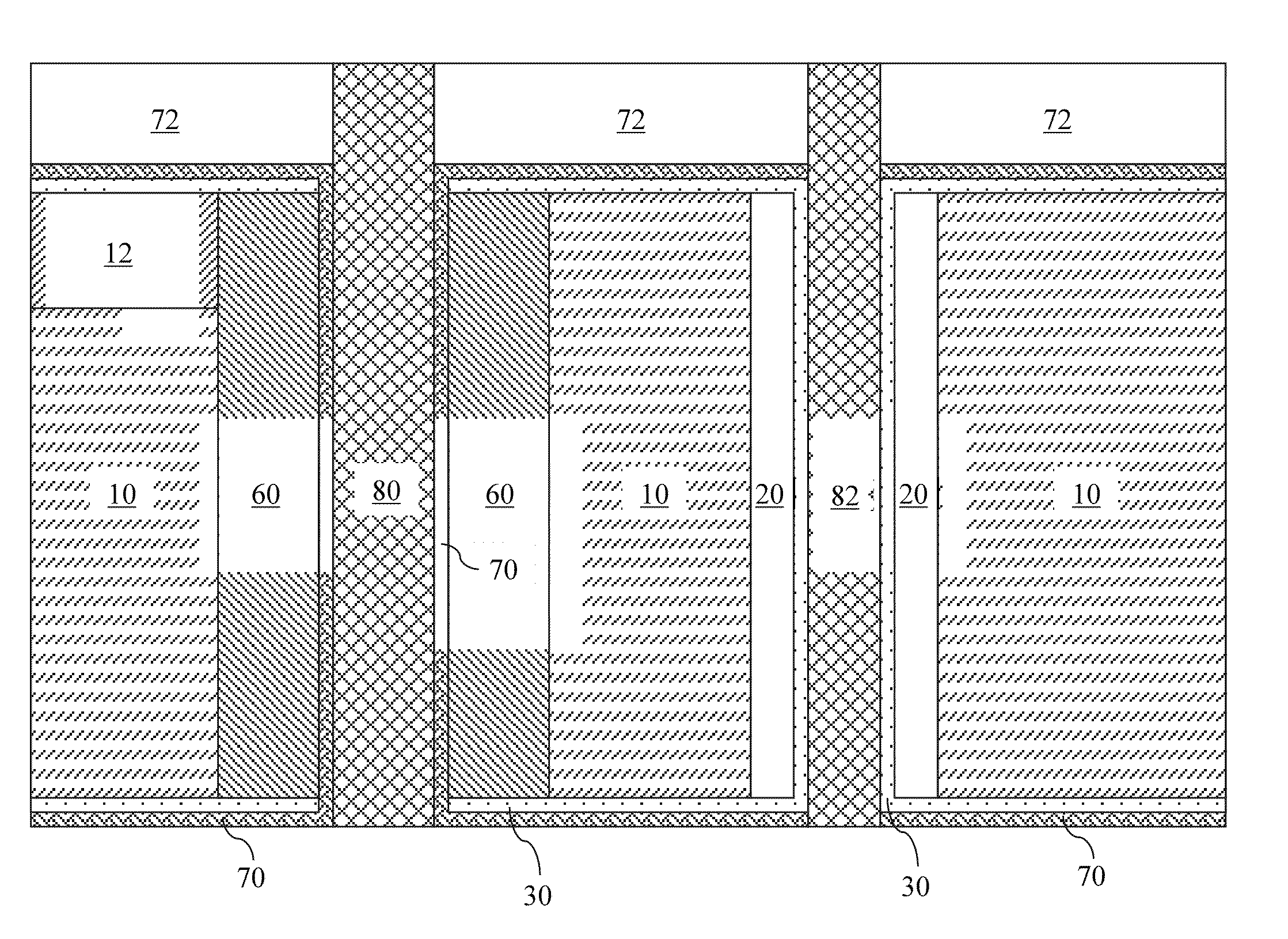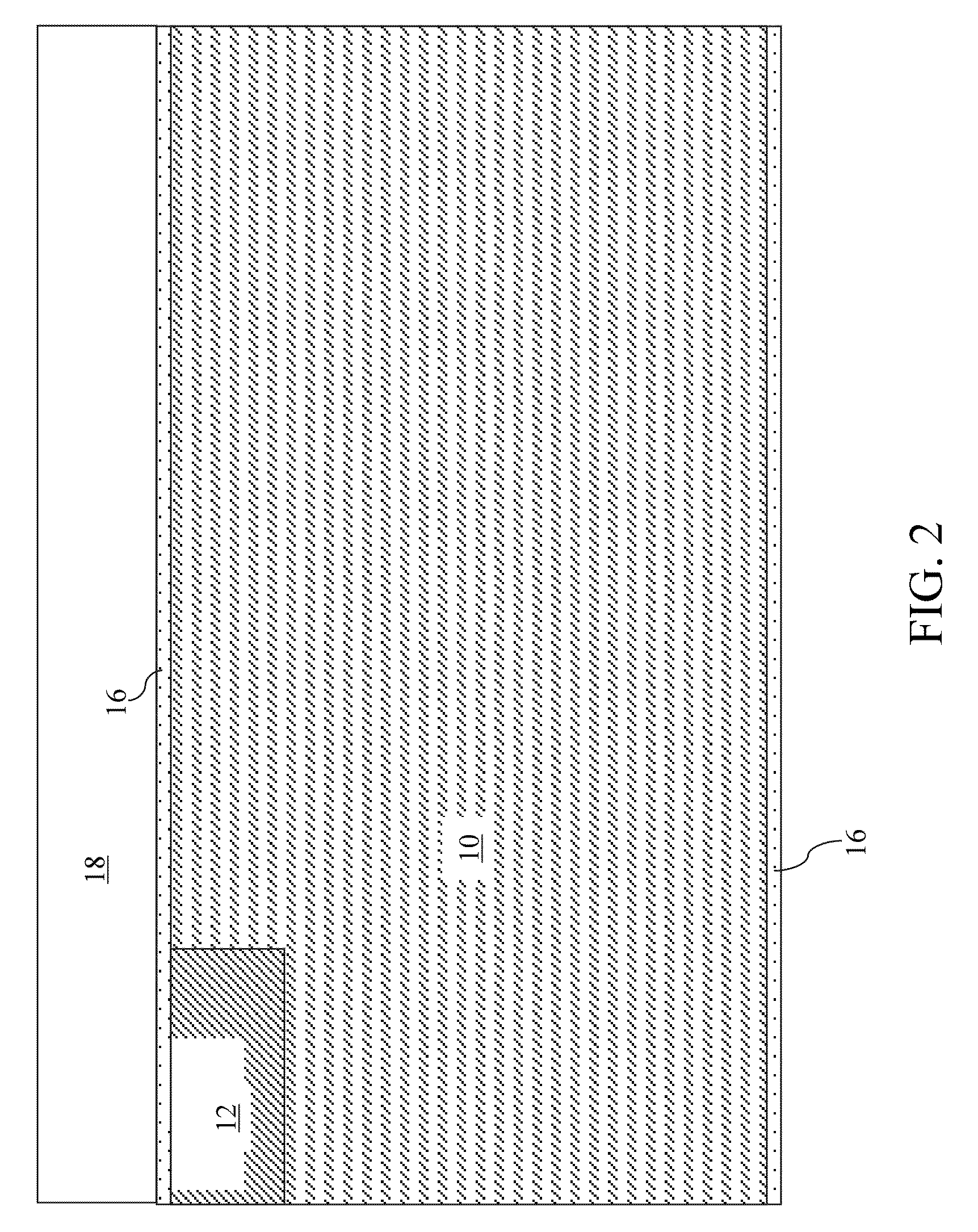Integrated decoupling capacitor employing conductive through-substrate vias
a decoupling capacitor and through-substrate technology, applied in capacitors, semiconductor devices, semiconductor/solid-state device details, etc., can solve the problems of adverse effects on the performance of off-chip drivers, the increase of reference supplies, and the performance of internal devices. achieve the effect of reducing high frequency noise and low inductan
- Summary
- Abstract
- Description
- Claims
- Application Information
AI Technical Summary
Benefits of technology
Problems solved by technology
Method used
Image
Examples
first embodiment
[0024]Referring to FIG. 1, a first exemplary structure according to the present invention includes a semiconductor substrate 10 that has a semiconductor material. The semiconductor material of the semiconductor substrate 10 can be selected from, but is not limited to, silicon, germanium, silicon-germanium alloy, silicon carbon alloy, silicon-germanium-carbon alloy, gallium arsenide, indium arsenide, indium phosphide, III-V compound semiconductor materials, II-VI compound semiconductor materials, organic semiconductor materials, and other compound semiconductor materials. Preferably, the semiconductor material of the semiconductor substrate 10 is a single crystalline material. For example, the semiconductor substrate 10 can be a single crystalline silicon layer. The semiconductor substrate 10 can be doped with dopants of a first conductivity type, which can be p-type or n-type. The dopant concentration of the semiconductor substrate 10 can be from 1.0×1014 / cm3 to 1.0×1017 / cm3.
[0025]A...
second embodiment
[0048]Referring to FIG. 19, a second exemplary structure according to the present invention includes a packaging substrate 200, a plurality of first semiconductor chips 100, a plurality of second semiconductor chips 300, an array of first solder balls 199 electrically connecting each of the first semiconductor chips 100 to the packaging substrate 200, and an array of second solder balls 299 electrically connecting each of the second semiconductor chips 300 to a first semiconductor chip 100. Each of the first semiconductor chips 100 includes at least one capacitor 180 and at least one laterally-insulated conductive through-substrate connection structure 182. The first semiconductor chips 100 may, or may not, include additional semiconductor devices such as field effect transistors, bipolar transistors, thyristors, and diodes. The second semiconductor chips 300 can include any type of semiconductor devices.
[0049]The capacitors 180 can function as decoupling capacitors that reduce nois...
third embodiment
[0050]Referring to FIG. 20, a third exemplary structure according to the present invention includes a packaging substrate 200, a interposer structure 400, a plurality of first semiconductor chips 100, and a plurality of second semiconductor chips 300. An array of first solder balls 199 electrically connects each of the first semiconductor chips 100 to the interposer structure 400. An array of second solder balls 299 electrically connects each of the second semiconductor chips 300 to a first semiconductor chip 100. An array of third solder balls 399 connects the interposer structure 400 to the packaging substrate 200.
[0051]The interposer structure 400 can include an interposer structure substrate layer 410, a lower dielectric material layer 420, and an upper dielectric material layer 430. The interposer structure substrate layer 410 includes a plurality of through-substrate via structures that are schematically illustrated as vertical lines. The plurality of through-substrate via str...
PUM
 Login to View More
Login to View More Abstract
Description
Claims
Application Information
 Login to View More
Login to View More - R&D
- Intellectual Property
- Life Sciences
- Materials
- Tech Scout
- Unparalleled Data Quality
- Higher Quality Content
- 60% Fewer Hallucinations
Browse by: Latest US Patents, China's latest patents, Technical Efficacy Thesaurus, Application Domain, Technology Topic, Popular Technical Reports.
© 2025 PatSnap. All rights reserved.Legal|Privacy policy|Modern Slavery Act Transparency Statement|Sitemap|About US| Contact US: help@patsnap.com



